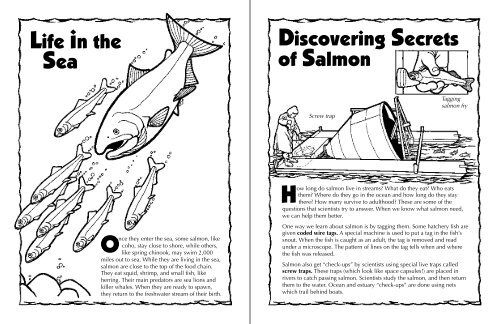The Pacific Salmon and Steelhead Coloring Book - U.S. Fish and ...
The Pacific Salmon and Steelhead Coloring Book - U.S. Fish and ...
The Pacific Salmon and Steelhead Coloring Book - U.S. Fish and ...
You also want an ePaper? Increase the reach of your titles
YUMPU automatically turns print PDFs into web optimized ePapers that Google loves.
Life in the<br />
Sea<br />
Once they enter the sea, some salmon, like<br />
coho, stay close to shore, while others,<br />
like spring chinook, may swim 2,000<br />
miles out to sea. While they are living in the sea,<br />
salmon are close to the top of the food chain.<br />
<strong>The</strong>y eat squid, shrimp, <strong>and</strong> small fish, like<br />
herring. <strong>The</strong>ir main predators are sea lions <strong>and</strong><br />
killer whales. When they are ready to spawn,<br />
they return to the freshwater stream of their birth.<br />
Discovering Secrets<br />
of <strong>Salmon</strong><br />
Screw trap<br />
Tagging<br />
salmon fry<br />
How long do salmon live in streams? What do they eat? Who eats<br />
them? Where do they go in the ocean <strong>and</strong> how long do they stay<br />
there? How many survive to adulthood? <strong>The</strong>se are some of the<br />
questions that scientists try to answer. When we know what salmon need,<br />
we can help them better.<br />
One way we learn about salmon is by tagging them. Some hatchery fish are<br />
given coded wire tags. A special machine is used to put a tag in the fish’s<br />
snout. When the fish is caught as an adult, the tag is removed <strong>and</strong> read<br />
under a microscope. <strong>The</strong> pattern of lines on the tag tells when <strong>and</strong> where<br />
the fish was released.<br />
<strong>Salmon</strong> also get “check-ups” by scientists using special live traps called<br />
screw traps. <strong>The</strong>se traps (which look like space capsules!) are placed in<br />
rivers to catch passing salmon. Scientists study the salmon, <strong>and</strong> then return<br />
them to the water. Ocean <strong>and</strong> estuary “check-ups” are done using nets<br />
which trail behind boats.

















